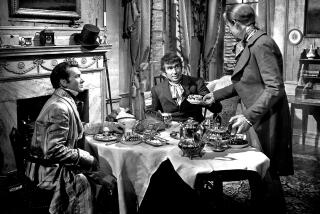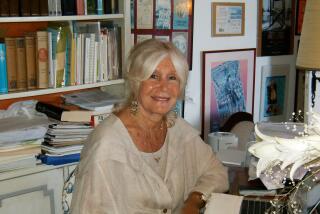Richard Matheson dies at 87; writer blended normal, inexplicable
In one of writer Richard Matheson’s last novels, when a radio psychologist complains that the woman his wife had just turned away from their door was “terribly disturbed,” his wife retorts, “Aren’t we all?”
That question was central in Matheson’s imagination, where the line between normal and out of this world was frighteningly fine. His stories and novels — including “I Am Legend” and “The Shrinking Man” — take place in the so-called real world, but the inexplicable abounds. The dark space under a couch is a passageway to an alien realm, a truck on a lonely road is possessed by evil, a telephone rings with a dead man’s voice.
Matheson, a master of science fiction, fantasy and horror who said he believed not in the supernatural but “the supernormal,” died Sunday of natural causes at his Calabasas home, said his son, screenwriter R.C. Matheson. He was 87.
“He fired my imagination by placing his horrors not in European castles and Lovecraftian universes, but in American scenes I knew and could relate to,” Stephen King, who cited Matheson as the author “who influenced me most,” wrote in a tribute posted on his website Tuesday.
Praised by Ray Bradbury as “one of the most important writers of the 20th century,” Matheson told stories that were frequently translated into films, including “The Incredible Shrinking Man” in 1957 and “Real Steel” in 2011.
His 1954 novel “I Am Legend,” about the last man to avoid the virus that turns people into vampires, was adapted three times: starring Vincent Price in 1964’s “The Last Man on Earth”; Charlton Heston in 1971’s “The Omega Man”; and Will Smith in 2007’s “I Am Legend.” Director George A. Romero has described his 1968 cult film “Night of the Living Dead” as an homage to Matheson.
His TV credits include more than a dozen episodes of “The Twilight Zone.” One of the most memorable was “Nightmare at 20,000 Feet,” featuring William Shatner as a passenger on an airplane who’s convinced that the flight is doomed by a gremlin on the wing. John Lithgow reprised the role in 1983’s “Twilight Zone: The Movie.”
“Duel,” the 1971 made-for-TV movie that was director Steven Spielberg’s first feature-length film, was based on Matheson’s adaptation of his short story about a truck that menaces a driver on a lonely road.
“For me,” Spielberg said in a statement about Matheson, “he is in the same category as Bradbury and [Isaac] Asimov.”
Born in Allendale, N.J., on Feb. 20, 1926, Matheson was the son of Norwegian immigrants who separated when he was about 8. He was raised by his mother who, he told The Times in 2005, “was very distrustful of the outside world.”
Her outlook left an impression on her son, who grew into a man whose children would sometimes call him “Mr. Paranoia.”
After serving in the Army during World War II, Matheson earned a journalism degree from the University of Missouri in 1949. In 1951 he moved to California, where he met his wife, Ruth Ann Woodson. They were married in 1952.
She survives him along with sons R.C. and Christian, daughters Ali Marie Matheson and Bettina Matheson Mayberry, seven grandchildren and two great-grandchildren.
He published his first short story, “Born of Man and Woman,” in the Magazine of Fantasy and Science Fiction in 1950. “It was a stunner,” writer Harlan Ellison, who knew Matheson for 50 years, recalled Tuesday of his friend’s tale about a mutant child kept in the basement by his parents. “It fit the world of genre writing like ‘Catcher in the Rye’ or ‘On the Road.’ I went seeking every story of his thereafter.”
The idea for “I Am Legend” came to him as a teenager when he saw the movie “Dracula.” It occurred to him that if one vampire was scary, “a whole world populated by vampires would be really scary,” he told the New York Times in 1994.
He did not develop the idea until 1952 when he and his wife were living in Gardena. He used their house as the model for the one protagonist Neville fortifies against the blood-sucking hordes with garlic, mirrors and crucifixes.
Reviewers noted that Matheson’s unadorned writing style suited his desire to make the familiar terrifying. “The almost clinical quality of his writing actually adds gravity to his horrors by giving them a solid and seemingly irrefutable basis in reality, no matter how outlandish they seem at first,” Stefan Dziemianowicz wrote in the “St. James Guide to Horror, Ghost and Gothic Writers.”
In the 1970s, the man named a Grand Master by the World Horror Convention “began to feel the darker work was not where his heart was anymore,” his son R.C. said. His fiction turned more spiritual, reflecting his growing belief in the afterlife. “Bid Time Return,” a 1975 novel later re-published as “Somewhere in Time,” and “What Dreams May Come,” published in 1978, both concerned loves that transcended time and place.
Both were made into movies, with “Somewhere in Time” (1980) starring Christopher Reeve and “What Dreams May Come” (1998) starring Robin Williams.
“I think we’re yearning for something beyond the every day,” Matheson told the entertainment website CinemaSpy several years ago. “And I will tell you I don’t believe in the supernatural, I believe in the supernormal. To me there is nothing that goes against nature. If it seems incomprehensible, it’s only because we haven’t been able to understand it yet.”
More to Read
Start your day right
Sign up for Essential California for the L.A. Times biggest news, features and recommendations in your inbox six days a week.
You may occasionally receive promotional content from the Los Angeles Times.







